一、RESTful
1.RESTful简介
REST:Representational State Transfer,表现层资源状态转移
①资源
将服务器看作是由很多离散的资源组成。每个资源是服务器上一个可命名的抽象概念
②资源的表述
源的表述可以有多种格式,例如HTML/XML/JSON/纯文本/图片/视频/音频
③状态转移
状态转移说的是:在客户端和服务器端之间转移(transfer)代表资源状态的表述。通过转移和操作资源的表述,来间接实现操作资源的目的。
2.RESTful的实现
①HTTP协议里面,四个表示操作方式的动词:GET、POST、PUT、DELETE
②对应四种基本操作:GET用来获取资源、POST用来新建资源、PUT用来更新资源、DELETE用来删除资源
③REST风格提倡URL地址使用统一的风格设计,都使用/,不使用问号,保证风格的一致性。

3.使用RESTful模拟操作用户资源
①UserController控制器
@Controller
public class UserController {
@RequestMapping(value = "/user",method = RequestMethod.GET)
public String getAllUser(){
System.out.println("查询用户信息");
return "success";
}
@RequestMapping(value = "/user/{id}",method = RequestMethod.GET)
public String getOneUser(){
System.out.println("查询id用户信息");
return "success";
}
@RequestMapping(value = "/user",method = RequestMethod.POST)
public String insertUser(String username,String password){
System.out.println("增加用户信息,用户名:"+username+"密码是:"+password);
return "success";
}
}
②test_rest.html页面
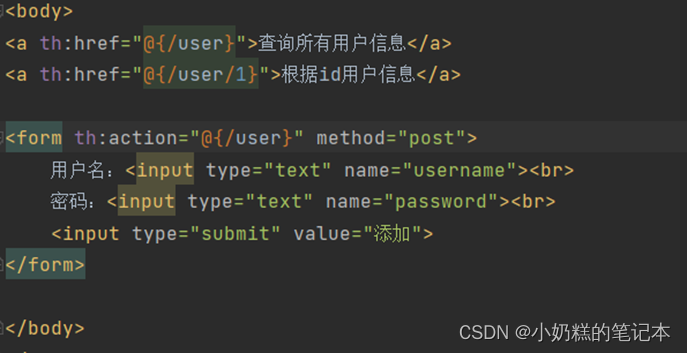
4. HiddenHttpMethodFilter
- 由于浏览器只支持get和post方式请求,发送put和delete请求需要使用SpringMVC 提供了 HiddenHttpMethodFilter
- HiddenHttpMethodFilter 处理put和delete请求的条件:
- a>当前请求的请求方式必须为post
-
b>当前请求必须传输请求参数_method
- 满足以上条件,HiddenHttpMethodFilter 过滤器就会将当前请求的请求方式转换为请求参数_method的值,因此请求参数_method的值才是最终的请求方式
①在web.xml,配置过滤器
<!--配置HiddenHttpMethodFilter-->
<filter>
<filter-name>HiddenHttpMethodFilter</filter-name>
<filter-class>org.springframework.web.filter.HiddenHttpMethodFilter</filter-class>
</filter>
<filter-mapping>
<filter-name>HiddenHttpMethodFilter</filter-name>
<url-pattern>/*</url-pattern>
</filter-mapping>
【注意】
①SpringMVC中提供了两个过滤器:CharacterEncodingFilter和HiddenHttpMethodFilter
②在web.xml中注册时,必须先注册CharacterEncodingFilter,再注册HiddenHttpMethodFilter
③原因是:在 CharacterEncodingFilter 中通过 request.setCharacterEncoding(encoding) 方法设置字符集的request.setCharacterEncoding(encoding) 方法要求前面不能有任何获取请求参数的操作。而 HiddenHttpMethodFilter 恰恰有一个获取请求方式的操作。

5.模拟PUT和DELETE请求
模拟PUT修改用户信息
①html页面(表单必须是POST,有一个_method方法,值是PUT)

②控制器
@RequestMapping(value = "/user",method = RequestMethod.PUT)
public String updateUser(String username,String password){
System.out.println("修改用户信息,用户名:"+username+password);
return "success";
}
二、RESTful具体案例
1.准备工作

①在bean包下创建Employee的javaBean
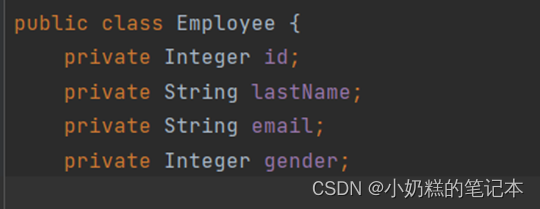
② 在dao包创建EmployeeDao.class
@Repository
public class EmployeeDao {
private static Map<Integer, Employee> employees = null;
static {
employees = new HashMap<Integer,Employee>();
employees.put(1001, new Employee(1001, "E-AA", "[email protected]", 1));
employees.put(1002, new Employee(1002, "E-BB", "[email protected]", 1));
employees.put(1003, new Employee(1003, "E-CC", "[email protected]", 0));
employees.put(1004, new Employee(1004, "E-DD", "[email protected]", 0));
employees.put(1005, new Employee(1005, "E-EE", "[email protected]", 1));
}
private static Integer initId = 1006;
public void save(Employee employee){
if (employee.getId() == null){
employee.setId(initId++);
}
employees.put(employee.getId(),employee);
}
public Collection<Employee> getAll(){
return employees.values();
}
public Employee get(Integer id){
return employees.get(id);
}
public void delete(Integer id){
employees.remove(id);
}
}
因为加了注解@Repository在dao开启扫描
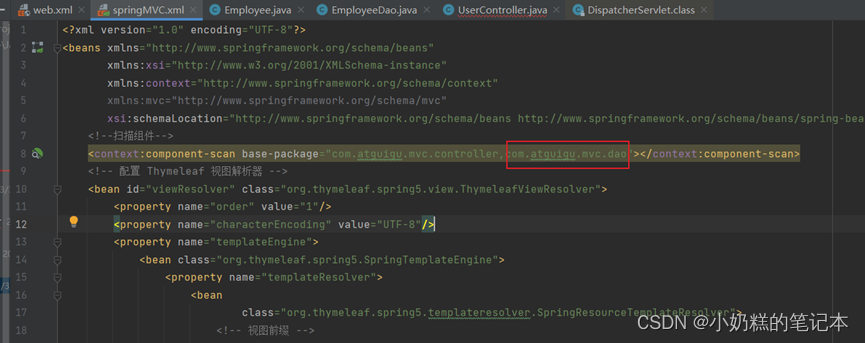
②在controller包下创建控制器
@Controller
public class EmployeeController {
@Autowired
private EmployeeDao employeeDao;
@RequestMapping("/")
public String index() {
return "index";
}
}
③Index.html页面

2.查询所有员工信息
①在控制器下编写
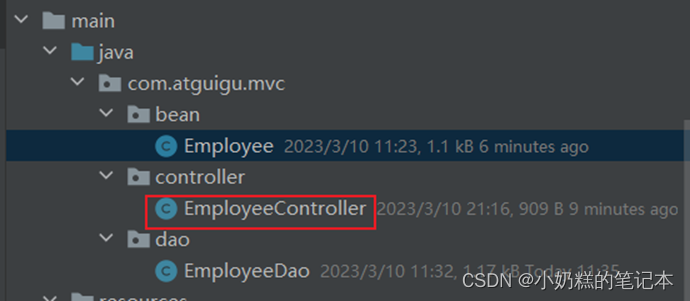
@RequestMapping(value = "/employee",method = RequestMethod.GET)
public String getEmployeeList(Model model) {
Collection<Employee> allemployee = employeeDao.getAll();
model.addAttribute("employeeList",allemployee);
return "employee_list";
}
②employee_list.html页面展示
<!DOCTYPE html>
<html lang="en" xmlns:th="http://www.thymeleaf.org">
<head>
<meta charset="UTF-8">
<title>所有员工信息</title>
</head>
<body>
<table border="1" cellpadding="0" cellspacing="0" style="text-align: center;" id="dataTable">
<tr>
<th colspan="5">Employee Info</th>
</tr>
<tr>
<th>id</th>
<th>lastName</th>
<th>email</th>
<th>gender</th>
<th>options</th>
</tr>
<tr th:each="employee:${employeeList}">
<td th:text="${employee.id}"></td>
<td th:text="${employee.lastName}"></td>
<td th:text="${employee.email}"></td>
<td th:text="${employee.gender}"></td>
<td>
<a href="">delete</a>
<a href="">update</a>
</td>
</tr>
</table>
</body>
</html>
效果
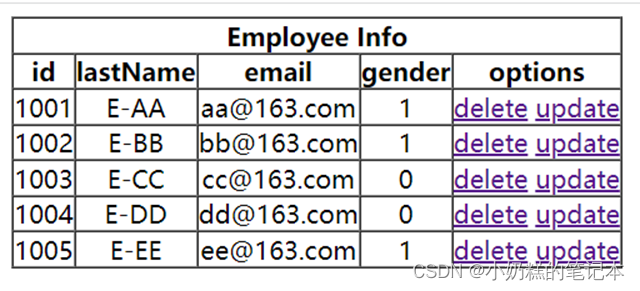
3.按id删除员工信息
①在employee_list.html页面,添加删除链接。特别注意th:action="@{/employee/}+${employee.id}"
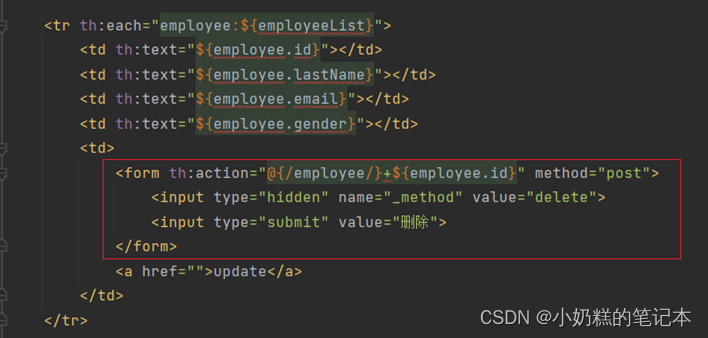
②点击删除按钮。在EmployeeController控制器下,通过@PathVariable("id")获取占位符的id值。重定向到列表页面
@RequestMapping(value = "/employee/{id}",method = RequestMethod.DELETE)
public String delete(@PathVariable("id") Integer id){ //@PathVariable("id")获取占位符的值
employeeDao.delete(id);
return "redirect:/employee";
}
4.添加员工信息

①点击添加按钮
@RequestMapping("/toAdd")
public String retunAdd(){
return "employee_add";
}
转发到添加页面employee_add.html
<!DOCTYPE html>
<html lang="en" xmlns:th="http://www.thymeleaf.org">
<head>
<meta charset="UTF-8">
<title>Title</title>
</head>
<body>
<form th:action="@{/employee}" method="post">
用户名:<input type="text" name="lastName"> <br>
邮箱:<input type="text" name="email"> <br>
性别:<input type="radio" name="gender" value="1">男
<input type="radio" name="gender" value="1">女<br>
<input type="submit" value="提交">
</form>
</body>
</html>
②在控制器方法执行添加操作,采用Employee employee保存请求数据。前提是form表单的name要和类属性名一致
@RequestMapping(value = "/employee",method = RequestMethod.POST)
public String addEmp(Employee employee){
employeeDao.save(employee);
return "redirect:/employee";
}
5.修改员工信息
①employee_list.html页面点击修改按钮
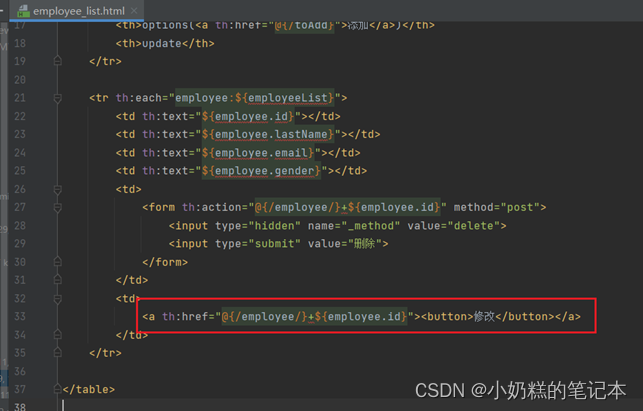
②执行控制器方法EmployeeController,根据id查询到要修改的对象,把他保存到Model域中。请求转发到employee_update.html
@RequestMapping(value = "/employee/{id}",method = RequestMethod.GET)
public String updateHtml(@PathVariable("id") Integer id,Model model){
Employee employee = employeeDao.get(id);
model.addAttribute("employee",employee);
return "employee_update.html";
}
③employee_update.html页面中,读取域对象。Post请求下的PUT方法。加上id隐藏域,请求转发到控制器
<!DOCTYPE html>
<html lang="en" xmlns:th="http://www.thymeleaf.org">
<head>
<meta charset="UTF-8">
<title>Title</title>
</head>
<body>
<form th:action="@{/employee}" method="post">
<input type="hidden" name="_method" value="put">
<input type="hidden" name="id" th:value="${employee.id}">
用户名:<input type="text" name="lastName" th:value="${employee.lastName}"> <br>
邮箱:<input type="text" name="email" th:value="${employee.email}"> <br>
性别:<input type="radio" name="gender" value="1" th:field="${employee.gender}">男
<input type="radio" name="gender" value="2" th:field="${employee.gender}">女<br>
<input type="submit" value="提交">
</form>
</body>
</html>
④EmployeeController控制器下。执行employeeDao.save(employee);实现修改。
@RequestMapping(value = "/employee",method = RequestMethod.PUT)
public String updateEmp(Employee employee){
employeeDao.save(employee);
return "redirect:/employee";
}